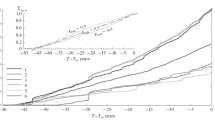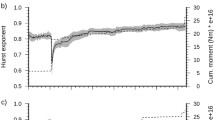Abstract
This work is a certain stage in investigations devoted to the recognition and examination of the seismic process dynamics in order to assess prospects and elaborate recommendations for the prediction of very strong earthquakes. The work is based on the use of the second-order differential equation, the so-called equation of the dynamics of self-developing processes, as an approximation model. Nine seismic catalogs including information about more than 1.5 million earthquakes were analyzed. The time behavior of three parameters characterizing the seismic process development, namely, the number of seismic events, accumulated conventional strain, and total energy of the events, was examined in terms of the model approximation. More than 17 000 well-defined seismic sequences of activation and attenuation were revealed using these parameters. The sequences account for about 38.5% of the total number of earthquakes from the catalogs studied. The remaining earthquakes belong to sequences of stationary development (in the form of background seismicity and earthquake swarms) and ill-defined sequences of activation and attenuation. The presence of stable regular patterns in the nonlinear development of the seismic process in time makes this process basically predictable. However, additional investigations are required for direct practical use of the regular features revealed in this work.
Similar content being viewed by others
References
A. A. Andronov, A. A. Vitt, and S. E. Khaikin, Theory of Vibrations (GIFML, Moscow, 1959) [in Russian].
P. Bak and C. Tang, “Earthquakes As a Self-Organized Critical Phenomenon,” J. Geophys. Res. 94(15), 635–637 (1989).
H. Benioff, “Earthquakes and Rock Creep. Part 1,” Bull. Seismol. Soc. Am. 51, 31–62 (1951).
G. Gershuni and E. M. Zhukhovitskii, Convective Stability of Incompressible Fluids (Nauka, Moscow, 1972) [in Russian].
Y. Huang, H. Saleur, C. G. Sammis, and D. Sornette, “Precursors, Aftershocks, Criticality and Self-Organized Criticality,” Europhys. Lett. 41, 43–48 (1998).
Y. Y. Kagan, “Observational Evidence for Earthquakes As a Nonlinear Dynamic Process,” Phys. D (Amsterdam) 77, 160–192 (1994).
C. Kisslinger and L. M. Jones, “Properties of Aftershocks Sequences in Southern California,” J. Geophys. Res. 96(11), 947–958 (1991).
A. I. Malyshev, “Dynamics of Self-Organizing Processes,” Vulkanol. Seismol., No. 4, 61–72 (1991).
A. I. Malyshev, Life of a Volcano (UrO RAN, Yekaterinburg, 2000) [in Russian].
A. I. Malyshev, I. N. Tikhonov, and K. Ts. Dugartsyrenov, A Method for Constricting Mathematical Models Describing Foreshock-Aftershock Sequences of Strong Kurile Earthquakes, Preprint Inst. of Marine Geology and Geophysics, Far East Division, Acad. Sci. of the USSR, Yuzhno-Sakhalinsk, 1992.
K. Mogi, “Seismicity before and after Large Shallow Earthquakes around the Japanese Islands,” Tectonophysics 175(1/3), 1–33 (1990).
G. Nikolis and I. Prigogine, Self-Organization in Non-Equilibrium Systems (Wiley, New York, 1977; Moscow, Mir, 1979).
F. Omori, “On the Aftershocks of Earthquake,” J. Col. Sci. Imp. Univ. Tokyo, No. 7, 111–200 (1894).
C. F. Richter, Elementary Seismology (Freeman, San Francisco, 1958; IL, Moscow, 1963).
A. Sornette and D. Sornette, “Renormalization of Earthquake Aftershocks,” Geophys. Res. Lett. 26(13), 1981–1984 (1999).
S. B. Stechkin and Yu. N. Subbotin, Splines in Computational Mathematics (Nauka, Moscow, 1976) [in Russian].
T. Utsu, “Magnitude of Earthquakes and Occurrence of Their Aftershocks,” Zesin2, No. 10, 35–45 (1957).
Author information
Authors and Affiliations
Additional information
Original Russian Text © A.I. Malyshev, I.N. Tikhonov, 2007, published in Fizika Zemli, 2007, No. 6, pp. 37–51.
Rights and permissions
About this article
Cite this article
Malyshev, A.I., Tikhonov, I.N. Nonlinear regular features in the development of the seismic process in time. Izv., Phys. Solid Earth 43, 476–489 (2007). https://doi.org/10.1134/S1069351307060067
Received:
Issue Date:
DOI: https://doi.org/10.1134/S1069351307060067




